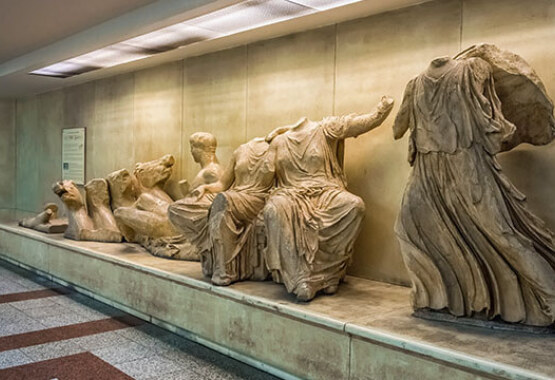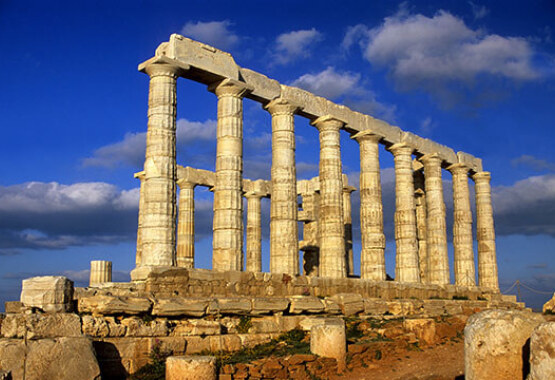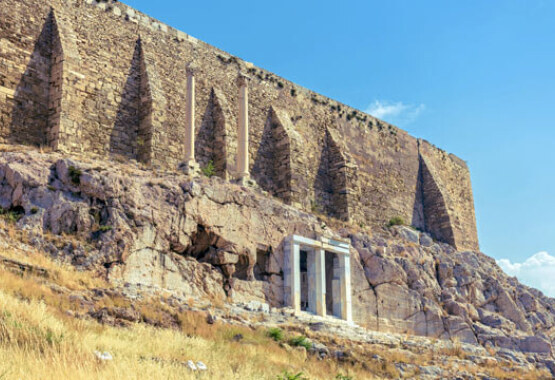
ATHENS
Other texts refer to the building simply as "temple" or "old temple". The building owes its unusual shape to the irregularity of the terrain - there is a three-metre difference in height between the eastern and western parts - and the multiple cults it was designed to accommodate. The eastern part of the building was dedicated to Athena Polias, while the western part served the cult of Poseidon-Erechtheus and held the altars of Hephaistus and Voutos, brother of Erechtheus. This is where, according to the myth, Athena's sacred snake lived. The sanctuary also contained the grave of Kekrops and the traces of the dispute between Athena and Poseidon for the possession of the city of Athens.
The temple was made of Pentelic marble, the frieze of grey stone from Elefsina with white relief figures attached to it and the foundations of Piraeus stone. On its east side, an Ionic portico with six columns sheltered the entrance to the east part of the building. Inside was the cult statue of Athena, made of olive wood, which the Arrhephoroi draped with the sacred peplos during the Panathenaic festival. On the north side is the entrance to the west part of the building, sheltered by a pi-shaped propylon with four Ionic columns along the facade and one on either side.
The stone paving of this propylon was thought to preserve the traces made by Poseidon's trident when it hit the ground and produced salt water. Under the temple's floor was, according to tradition, the "Erechtheis Sea" where the waters from Poseidon's salt-water spring gathered. A small door on the west side led to the sanctuary of Pandrosos, which stood west of the Erechtheion. Four Ionic columns on a high stylobate, with metal railings between them, adorned the west facade.
Finally, another door on the south facade of the western temple opened onto the porch of the Karyatides, a pi-shaped structure with six female statues instead of columns to support the roof. Created by Alkamemes or Kallimachos, the statues were later named Karyatides after the young women from Karyes of Laconia who danced in honour of the goddess Artemis. Five of them are in the Acropolis Museum and another in the British Museum; those on the building are casts. The frieze probably depicted scenes related to the mythical kings of Athens.
The temple burned in the first century BC and was subsequently repaired with minor alterations. In the Early Christian period it was converted into a church dedicated to the Theometor (Mother of God). It became palace under Frankish rule and the residence of the Turkish commander's harem in the Ottoman period. In the early nineteenth century, Lord Elgin removed one of the Karyatides and a column and during the Greek War of Independence the building was bombarded and severely damaged.
Restoration was undertaken immediately after the end of the war and again in 1979-1987, when the Erechtheion became the first monument of the Acropolis to be restored as part of the recent conservation and restoration project. Its restoration received the Europa Nostra award.
Erechtheion
The elegant building known as the Erechtheion, on the north side of the sacred rock of the Acropolis, was erected in 421-406 BC as a replacement of an earlier temple dedicated to Athena Polias, the so-called "Old temple". The name Erechtheion, mentioned only by Pausanias (1, 26, 5), derives from Erechtheus, the mythical king of Athens, who was worshipped there.Other texts refer to the building simply as "temple" or "old temple". The building owes its unusual shape to the irregularity of the terrain - there is a three-metre difference in height between the eastern and western parts - and the multiple cults it was designed to accommodate. The eastern part of the building was dedicated to Athena Polias, while the western part served the cult of Poseidon-Erechtheus and held the altars of Hephaistus and Voutos, brother of Erechtheus. This is where, according to the myth, Athena's sacred snake lived. The sanctuary also contained the grave of Kekrops and the traces of the dispute between Athena and Poseidon for the possession of the city of Athens.
The temple was made of Pentelic marble, the frieze of grey stone from Elefsina with white relief figures attached to it and the foundations of Piraeus stone. On its east side, an Ionic portico with six columns sheltered the entrance to the east part of the building. Inside was the cult statue of Athena, made of olive wood, which the Arrhephoroi draped with the sacred peplos during the Panathenaic festival. On the north side is the entrance to the west part of the building, sheltered by a pi-shaped propylon with four Ionic columns along the facade and one on either side.
The stone paving of this propylon was thought to preserve the traces made by Poseidon's trident when it hit the ground and produced salt water. Under the temple's floor was, according to tradition, the "Erechtheis Sea" where the waters from Poseidon's salt-water spring gathered. A small door on the west side led to the sanctuary of Pandrosos, which stood west of the Erechtheion. Four Ionic columns on a high stylobate, with metal railings between them, adorned the west facade.
Finally, another door on the south facade of the western temple opened onto the porch of the Karyatides, a pi-shaped structure with six female statues instead of columns to support the roof. Created by Alkamemes or Kallimachos, the statues were later named Karyatides after the young women from Karyes of Laconia who danced in honour of the goddess Artemis. Five of them are in the Acropolis Museum and another in the British Museum; those on the building are casts. The frieze probably depicted scenes related to the mythical kings of Athens.
The temple burned in the first century BC and was subsequently repaired with minor alterations. In the Early Christian period it was converted into a church dedicated to the Theometor (Mother of God). It became palace under Frankish rule and the residence of the Turkish commander's harem in the Ottoman period. In the early nineteenth century, Lord Elgin removed one of the Karyatides and a column and during the Greek War of Independence the building was bombarded and severely damaged.
Restoration was undertaken immediately after the end of the war and again in 1979-1987, when the Erechtheion became the first monument of the Acropolis to be restored as part of the recent conservation and restoration project. Its restoration received the Europa Nostra award.




